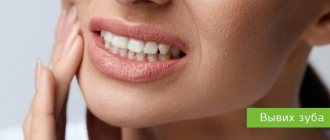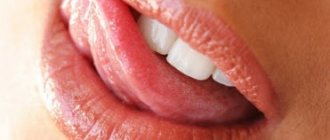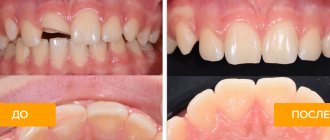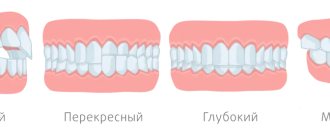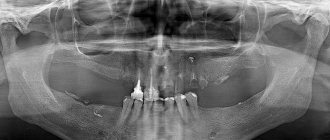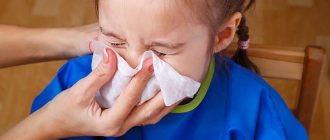Playing on playgrounds, accidental falls, road accidents, fights, sports - all this is life, so every person has a chance of injuring their teeth.
restoration of a lost tooth with a crown on an implant
It’s good that for adults in case of injury and loss of permanent teeth, there are dental implants and other types of prosthetics.
restoration of a lost tooth with an “adhesive bridge”
But if you know how to provide first aid correctly and what to do next, there is a great chance of saving your teeth.
Our instructions will help you not to get confused and act without delay, but first, two important notes:
1) If you witness a dental injury, first assess the situation and if you think that immediate medical attention is required , go to the emergency room or call an ambulance to the scene. There are injuries, for example, a concussion, a broken jaw, that require urgent hospitalization. In such cases, you will have to think about the condition of your teeth and the aesthetics of your smile later, when the threat to life and health has passed.
2) Do not put off visiting a doctor even if, in your opinion, the injury is minor (for example, a bruised tooth without visible damage). It's better to play it safe and visit a dentist. He will conduct an examination, take diagnostic images, and, if necessary, refer you to other specialists. Only after this can you breathe easy and be sure that your teeth and health in general are in order.
The most common dental injuries
Tooth luxation:
- complete luxation (the tooth has fallen out of its socket)
- partial luxation (the tooth has moved but has not fallen out)
- impacted dislocation (the crown part of the tooth is pressed into the gum and bone; the tooth becomes shorter in appearance, and perhaps it is completely invisible).
Tooth fracture:
- chipped piece of enamel
- chipping of the crown within the dentin without damage to the dental pulp
- fracture of the tooth crown with damage to the pulp (blood is visible at the fracture site)
- tooth root fracture
When teeth are injured, soft tissues (lips and gums), the alveolar process (the bone in which the tooth root is located) and the jaw can be damaged. This creates an additional psychological impact on the victim and people providing assistance. Don't panic and stay calm.
Why do the necks of teeth become exposed and how to restore gums?
Quite often, patients come to me with complaints of increased tooth sensitivity. It is impossible to drink cold water in the summer without eating ice cream.
Typically, gum recession is to blame. Let's figure out what it is and what can and should be done to enjoy delicious ice cream without discomfort.
Gum recession is the exposure of the neck of the tooth, which is accompanied by aesthetic discomfort and increased sensitivity.
Why does gum recession occur?
Gum recession occurs for many reasons.
The main reasons for a recession are:
- Hygiene. Plaque and tartar that are not removed in a timely manner lead to “squeezing” of the gums and exposure of the neck of the tooth. Also, overly aggressive poor home hygiene leads to the same consequences.
- Pathological bite. When the tooth is positioned incorrectly, when the tooth is tilted in one direction or another, or when there is severe crowding, the periodontium (the complex of tissues surrounding and holding the tooth) is overloaded, which leads to a reduction in the gums and exposure of the tooth root.
Treatment of gum recession.
A very important point is that during recessions, not only gum loss occurs, but also loss of BONE TISSUE in the tooth area. Based on this, if you do not pay attention to this problem in a timely manner, it can lead to further mobility and loss of teeth.
Surgery is the main treatment for gum recession. Thanks to different techniques, the gingival contour is restored and the tooth root is closed.
If the cause of recession is associated with a pathological bite, then in such a situation it is necessary to first carry out orthodontic treatment and, after completion, resort to surgical methods.
In some cases, with proper orthodontics, the recession is closed without resorting to surgery.
Gum recession classification.
Depending on the severity of the current, recessions occur
- Mild form - the gums recede no more than 3mm.
- Medium shape - the gums drop by 3-5mm.
- Severe form – the gums recede by more than 5mm.
With regards to the coverage of the oral cavity, the pathology can have both local and generalized distribution.
Treatment of gum recession.
The main essence of the surgical technique is taking your own tissue (from the palate or the tubercle of the upper jaw) and suturing it in the defect area, thereby increasing the volume of soft tissue.
The relevance of this technique remains in both localized and generalized forms. Its advantage is considered to be effective restoration, since the materials are 100% identical. The only drawback of the manipulation is the feeling of slight discomfort for some time at the site of donor tissue collection. There are also cases when the flap does not take root in the transplanted area. As a rule, this happens due to poor hygiene and failure to follow the recommendations given by the doctor.
A favorable prognosis ensures timely seeking qualified help. Therefore, you should not put off your visit to the dentist, since the outcome of treatment depends on this.
How to stop gum recession!
- if there are dental diseases and other injuries to the oral cavity, then it is necessary to treat them in a timely manner - this applies to a greater extent to caries, which patients often bring to an advanced state (becomes complicated forms);
- regularly visit the dentist for a preventive examination: as you know, early diagnosis allows you to quickly eliminate the problem, without radical intervention, without waiting for serious health problems;
- monitor the condition of the gingival margin, avoiding injury and excessive bleeding;
- correct the bite in a timely manner;
- do not forget about strengthening tooth enamel with the help of remineralizing treatment;
- pay special attention to hygiene - effective brushing of teeth, choice of brush and toothpaste.
One of my works:
Preparation (closure of recession) was carried out before orthodontic treatment. After orthodontic treatment, cosmetic removal of remaining recessions is planned.
COMPLETE TOOTH DISlocation. What to do?
When completely dislocated, the tooth fell out of its socket.
ATTENTION . The recommendations below apply to permanent teeth only. It is impossible to set baby teeth back into place , as the rudiments of permanent teeth can be damaged.
Act quickly , you have about 20 minutes to find the lost tooth and return it to the hole in its usual place! In this case, there is a high chance of tooth engraftment (replantation).
tooth replantation step by step
- find the missing tooth.
- hold the tooth by the crown (the white part of the tooth) and try not to touch the root to avoid damaging the periodontal cells.
- If the tooth is dirty, quickly rinse it with running cold water (maximum 10 seconds).
- return the tooth to the socket, placing it in its usual position (focus on a symmetrical tooth)
- To hold the tooth in place, you need to bite on a gauze pad or handkerchief.
If there are reasons that do not allow the tooth to be returned to its socket (for example, the patient is unconscious), place the fallen tooth in a container of milk . If the patient is conscious, he can place the fallen tooth behind his lip or cheek. But if there is a danger that the person will swallow the tooth, ask them to spit the saliva into a small container and place the tooth there. You can also use saline solution sold at the pharmacy for storage, but avoid storing the tooth in water.
Now you need to urgently consult a dentist for examination and further treatment.
How to save a loose tooth
Medical tactics depend on the diagnosis. The patient is asked to undergo X-ray diagnostics. This is the best way to study the origins of the problem. From the images, the doctor can determine the degree of destruction of bone tissue and, based on the information received, decide what to do next. If periodontitis is to blame, dental plaque is removed. It is especially important to thoroughly clean the periodontal pockets and interdental spaces. It is best to remove stones using ultrasound. This method is safe and does not cause serious discomfort.
Additionally, the client is prescribed an antibacterial drug. This is necessary to quickly relieve the inflammatory process. If there is significant root destruction, splinting may be required. During the procedure, the dentist drills a small groove on the surface of adjacent teeth and places a miniature fiberglass splint into it. Afterwards, the cavity is closed with a filling compound. This measure makes it possible to securely fix the movable unit and avoid its removal in the coming years. If your teeth are loose due to bruxism - involuntary grinding at night - it is necessary to make a custom night guard. The patient should put it on every time before going to bed. In parallel, he is prescribed a course of vitamin-mineral medications and anticonvulsants. Dentists are asked to pay special attention to oral hygiene. Without it, dental health is impossible. To prevent the accumulation of stone, you need to use dental floss, an irrigator, and special interdental brushes. Moreover, this should be done not from time to time, but daily.
PARTIAL TOOTH DISlocation. What to do?
With partial dislocation, the tooth has shifted, may be movable, but has not fallen out of the socket.
- do not spit out blood, do not touch or pull out a tooth, even if it prevents you from closing your mouth.
- urgently contact a dentist so that he can conduct an examination, return the injured tooth to the correct position and apply a splint for fixation.
If the dentist is unavailable for the next few hours, try to use light pressure to return the tooth to its usual position (focus on a symmetrical tooth). To hold the injured tooth in place, you need to bite down on a gauze pad or gently clench your teeth together.
Is it necessary to remove a loose tooth?
In some situations this procedure cannot be avoided, but the main thing here is not to rush. Before drawing up a treatment plan, the dentist conducts an in-person diagnosis - examines the oral cavity, takes X-rays and studies the condition of the roots. The less damage is detected, the greater the chances of successful prosthetics. You won’t be able to do without deletion if:
- pronounced mobility;
- the infectious process is severely advanced.
At the same time, patients at dental clinics should understand that doctors are doing everything possible to maintain the integrity of their bite. Therefore, it is important to trust your doctor and strictly follow all his instructions. This approach will allow you to get excellent results in a short time.
TOOTH FRACTURE. What to do?
As we wrote above, the following injuries include tooth fractures:
- chipped piece of enamel
- chipping of the crown within the dentin without damage to the dental pulp
- fracture of the tooth crown with damage to the pulp (blood is visible at the fracture site)
- tooth root fracture
Root fractures can be of more complex types:
In all these cases the recommendation is the same:
- If possible, find all the broken tooth fragments and place them in water
- No emergency visit to the dentist is required; make an appointment this day or the next .
INJURY OF MILK TEETH. What to do?
Baby teeth can be injured just like permanent teeth, but first aid and treatment tactics are different.
An important feature that determines “what to do” is the proximity of the roots of baby teeth to the rudiments of permanent teeth. Therefore, in case of injury, the main concern is the preservation of future (permanent) teeth.
Nevertheless, if it is possible to preserve baby teeth without harm to permanent teeth, the dentist will act this way. The goal of treatment is to organize the healing process of the periodontium (tissues surrounding the tooth) and the pulp of the baby tooth, provided that this does not harm the formation of permanent teeth.
